|
|
|
Sort Order |
|
|
|
Items / Page
|
|
|
|
|
|
|
| Srl | Item |
| 1 |
ID:
115189
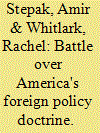

|
|
|
|
|
| Publication |
2012.
|
| Summary/Abstract |
One balmy Washington evening in June 2011, President Barack Obama was set to deliver a highly anticipated address declaring the drawdown of US forces in Afghanistan. What he delivered, however, was much more. In his speech, Obama laid out a clear foreign-policy doctrine, touching on the role the United States should play in world affairs, the values it holds dear, and the principles guiding its use of force and diplomatic efforts. Rejecting the divergent paths of isolationism and expansionism, Obama called for 'a more centered course':
|
|
|
|
|
|
|
|
|
|
|
|
|
|
|
|
| 2 |
ID:
115193
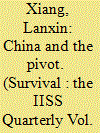

|
|
|
|
|
| Publication |
2012.
|
| Summary/Abstract |
The Obama administration seems to have toned down its rhetoric on Asia-Pacific security, abandoning the fancy but problematic phrase 'pivot towards Asia' and replacing it with the more prosaic 'rebalancing'. This does not mean the content of US policy is very different. On the contrary, the Obama administration continues its military build-up in the region, aiming at a military posture that can only be described as 'absolute superiority'. Over the past two years, Washington has put together a comprehensive 'containment' package in Asia that includes a new military doctrine of air-sea battle; launched a game-changing economic project called the Trans-Pacific Partnership; initiated the 'rotation' of US marines in Australia; and stationed coastal battleships in Singapore. More alarmingly, the United States is making clear attempts to re-establish a naval presence in Subic Bay in the Philippines, and in the coveted Cam Ranh Bay in Vietnam. Both were key US naval bases during the Cold War.
|
|
|
|
|
|
|
|
|
|
|
|
|
|
|
|
| 3 |
ID:
115194
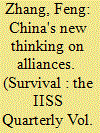

|
|
|
|
|
| Publication |
2012.
|
| Summary/Abstract |
In December 1949, Mao Zedong, paramount leader of the newly founded People's Republic of China, travelled to Moscow to negotiate a military alliance with the Soviet Union. Within barely two decades, however, not only had the alliance collapsed, but the two former allies had become bitter ideological and military adversaries. Strategic exigencies compelled the Chinese leadership to seek rapprochement with the United States, producing a quasi-alliance between the two erstwhile enemies after 1972. In January 1979, during his visit to Washington, Deng Xiaoping sought to nudge the United States toward developing a de facto, if informal, alliance with China in order to secure American support for China's impending invasion of Vietnam. During the last decade of the Cold War, China and the United States also maintained a degree of strategic cooperation against the Soviet Union.
|
|
|
|
|
|
|
|
|
|
|
|
|
|
|
|
| 4 |
ID:
115188
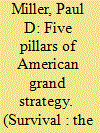

|
|
|
|
|
| Publication |
2012.
|
| Summary/Abstract |
In a previous Survival article, I argued that, contrary to widespread belief, the United States has been pursuing at least one pillar of an implicit grand strategy since the end of the Cold War: building the democratic peace. The democratic peace has informed most major US foreign-policy initiatives over at least the last two decades, and rightly so: it has many strengths to recommend it, including its harmony with values the American electorate broadly shares. But championing liberalism is only one component of US grand strategy. There are four others: defending the American homeland from attack, maintaining a favourable balance of power among the great powers, punishing rogue actors, and investing in good governance and allied capabilities abroad. Like support for democracy, these broad goals are well within the mainstream of US foreign policy; they enjoy bipartisan support, and have been remarkably consistent for decades.
|
|
|
|
|
|
|
|
|
|
|
|
|
|
|
|
| 5 |
ID:
115196


|
|
|
|
|
| Publication |
2012.
|
| Summary/Abstract |
The United States has launched, in effect, an economic, political, cyber and covert war with Iran. American-Iranian relations could reach a turning point within a year. Without substantial progress on the diplomatic front, the chance for a unilateral Israeli or a joint US-Israeli military campaign aimed at destroying the Iranian nuclear programme could become a probability. Any attempt to reorient the current diplomatic trajectory will require a better understanding of the dispute between Tehran and Washington over nuclear and other weapons of mass destruction (WMD).
|
|
|
|
|
|
|
|
|
|
|
|
|
|
|
|
| 6 |
ID:
115191
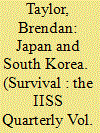

|
|
|
|
|
| Publication |
2012.
|
| Summary/Abstract |
Japan-South Korea security relations seemed to be going so well. The two countries, along with their American ally, met on the sidelines of the June 2012 IISS Shangri-La Dialogue in Singapore and formally agreed to institutionalise a ministerial-level defence trilateral. During the same month, Japan, South Korea and the United States conducted joint naval exercises in the Yellow Sea, not far from China and the Korean Peninsula. At least one respected authority on Korean Peninsula security issues (Peter Beck) has even advocated the establishment of a formal alliance relationship between Tokyo and Seoul.
|
|
|
|
|
|
|
|
|
|
|
|
|
|
|
|
| 7 |
ID:
115192
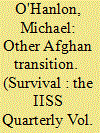

|
|
|
|
|
| Publication |
2012.
|
| Summary/Abstract |
Afghanistan policy debates in NATO capitals these days are about transition. Specifically, by 2014, the NATO-run International Security Assistance Force (ISAF) operation is to end, according to a schedule first proposed by President Hamid Karzai of Afghanistan and later reaffirmed by outside powers at NATO's Lisbon Summit in 2010. By that point, Afghans will have primary security responsibility for all parts of their country - a goal that they will technically reach in 2013, according to the latest plans - and nearly all ISAF troops will be able to depart. The May 2012 strategic partnership agreement between the United States and Afghanistan, reinforced by several other such bilateral accords, will guide relations thereafter; the July 2012 Tokyo donors' conference has added further detail to plans. With these pieces in place, Western policy debates tend to dwell on how fast to bring troops home between now and the end of 2014.
|
|
|
|
|
|
|
|
|
|
|
|
|
|
|
|
| 8 |
ID:
115190
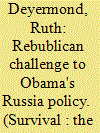

|
|
|
|
|
| Publication |
2012.
|
| Summary/Abstract |
In the two decades since the collapse of the Soviet Union, relations between the United States and Russia have oscillated between optimism and mutual suspicion. The second administration of George W. Bush (2005-09) is widely acknowledged as the lowest point in post-Cold War bilateral relations, with conflict over a range of prominent and sensitive issues such as missile defence, NATO enlargement, the practice and promotion of democracy, and the August 2008 Russia-Georgia War. In the last years of this period, the question of whether this represented the start of a 'new Cold War' was widely discussed.
|
|
|
|
|
|
|
|
|
|
|
|
|
|
|
|
| 9 |
ID:
115195
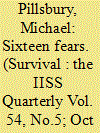

|
|
|
|
|
| Publication |
2012.
|
| Summary/Abstract |
During the Cold War, an influential group of American defence planners sought to understand Soviet defence decisions by grasping the Soviet mind, including exploring how the Soviet generals thought about war and their opponents. This was achieved only through intensive intelligence collection and intellectual analysis, including extensive use of open sources. It was a process which, as George Kennan put it in his analysis of Soviet thinking, 'would require living with contradictions'.
|
|
|
|
|
|
|
|
|
|
|
|
|
|
|
|
|
|
|
|
|